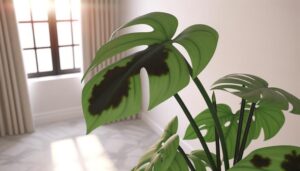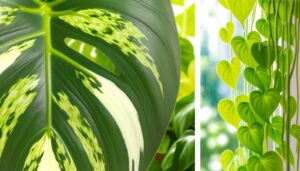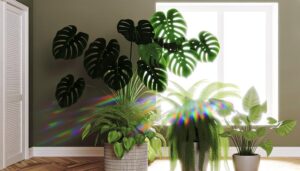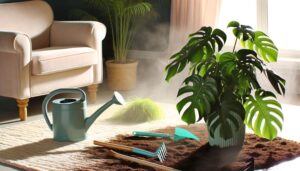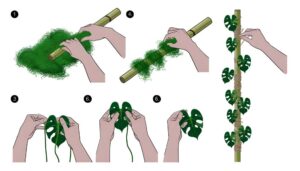Comparison: Monstera King Vs Monstera Deliciosa
Monstera King and Monstera Deliciosa, both from the Araceae family, possess unique morphological and physiological features. Monstera King has larger leaves (over 100 cm) with denser fenestrations, enhancing light penetration and wind resistance.
Monstera Deliciosa, with broad leaves (60-90 cm), favors sporadic fenestrations for enhanced photosynthesis. Monstera King exhibits faster growth and tolerates lower light conditions compared to Monstera Deliciosa, which requires consistent bright, indirect light.
Monstera King needs regular watering, while Monstera Deliciosa prefers drying out slightly between waterings. For more insights on their soil preferences, pest management, and ideal growing conditions, continue on.
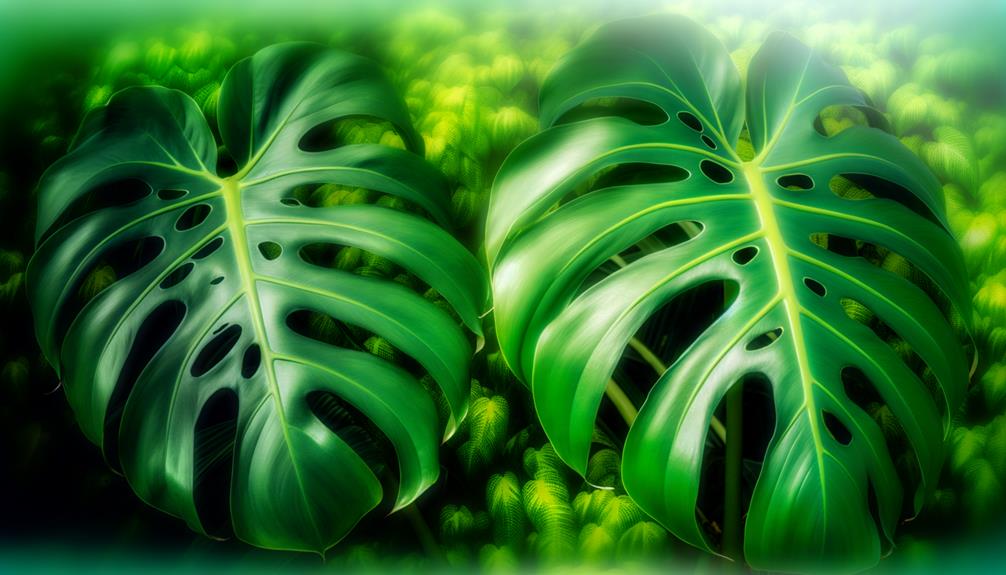
Key Takeaways
- Monstera King has larger leaves (over 100 cm) compared to Monstera Deliciosa's 60-90 cm leaves.
- Monstera King's fenestrations are denser and smaller, enhancing light penetration and air circulation.
- Monstera King grows faster due to its larger leaf surface area and efficient nutrient uptake.
- Monstera King tolerates lower light conditions better than Monstera Deliciosa, which requires consistent bright, indirect light.
- Both species contain insoluble calcium oxalates, posing toxicity risks to pets if ingested.
Origins and Background
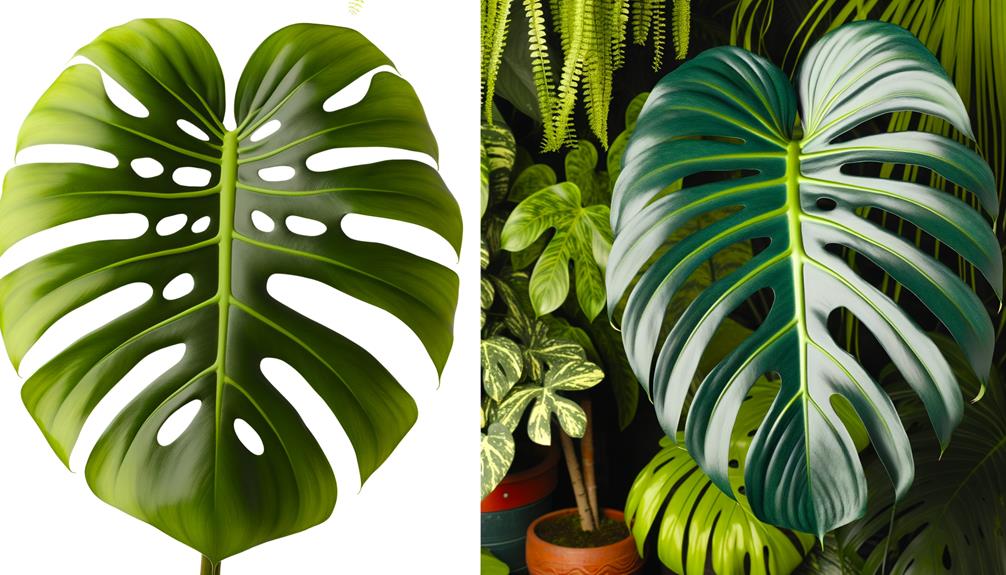
The Monstera King and Monstera Deliciosa, both members of the Araceae family, originate from the tropical rainforests of Central and South America, where they have evolved distinct morphological and physiological traits suited to their respective ecological niches.
Monstera Deliciosa, commonly known as the Swiss Cheese Plant, thrives in the understory environment, utilizing its aerial roots to climb and access sunlight.
In contrast, the Monstera King, though less well-known, exhibits adaptations that enable it to withstand varying humidity and light conditions. Both species employ a unique mechanism of fenestration—leaf perforations—which is hypothesized to reduce wind resistance and optimize light capture.
Understanding these origins and ecological adaptations is pivotal for horticulturists aiming to replicate natural conditions in cultivation.
Leaf Structure
The leaf structure of Monstera King and Monstera Deliciosa exhibits remarkable differences in both size and fenestration patterns.
Monstera King typically features larger leaves, which can notably impact light absorption and photosynthetic efficiency.
Additionally, the unique fenestration patterns—characterized by the presence and arrangement of natural perforations—differ noticeably between the two species, affecting their overall aesthetic and functional adaptations.
Leaf Size Differences
Distinct variations in leaf size and structure characterize Monstera King and Monstera Deliciosa, offering key morphological differences for accurate identification.
Monstera Deliciosa, renowned for its prominent, broad leaves, typically exhibits dimensions ranging from 60 to 90 centimeters in length, making it a staple in botanical collections.
Conversely, Monstera King displays considerably larger foliage, often exceeding 100 centimeters in length, with a more robust and leathery texture. These substantial differences in leaf size are indicative of their respective growth environments and genetic lineage.
While both species share a common genus, the pronounced leaf size diversity serves as an essential diagnostic feature, aiding botanists and horticulturists in distinguishing between these two visually similar yet distinct Monstera variants.
Unique Fenestration Patterns
While both Monstera King and Monstera Deliciosa exhibit fenestrations, the former showcases a more intricate and densely packed pattern of perforations, reflecting its unique evolutionary adaptations.
Monstera King leaves often present smaller, more frequent fenestrations, which enhance light penetration and air circulation, essential for their natural habitat's microclimate.
In contrast, Monstera Deliciosa leaves feature larger, more sporadic fenestrations, optimizing their role in maximizing photosynthetic efficiency in shaded environments.
The variation in fenestration density and morphology between these species underscores their distinct ecological niches.
Detailed anatomical studies have revealed that Monstera King's fenestrations may also contribute to its enhanced structural strength, reducing wind resistance and potential physical damage, a crucial adaptation in its native, more turbulent habitats.
Growth Rate
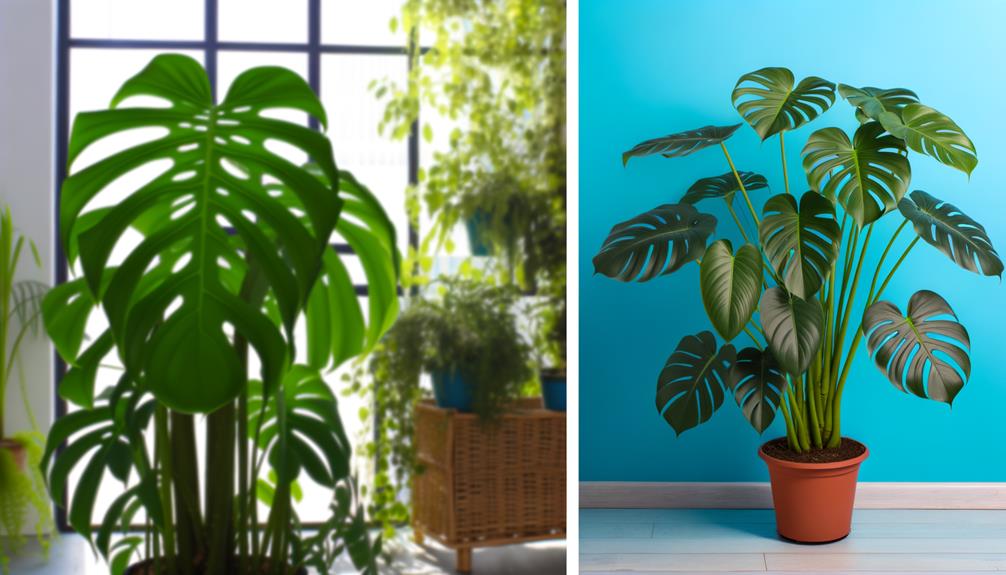
Monstera King displays a faster growth rate compared to Monstera Deliciosa, attributable to its larger leaf surface area and enhanced photosynthetic efficiency. This increased surface area maximizes light capture, facilitating greater photosynthetic activity and, thus, more rapid biomass accumulation.
Additionally, Monstera King's robust root system enables efficient nutrient uptake, further accelerating growth. In contrast, Monstera Deliciosa, while also a vigorous grower, demonstrates a relatively slower rate of leaf and stem development. This difference can be linked to its comparatively smaller leaves and less aggressive root proliferation.
Both species, however, exhibit a notable capacity for aerial root production, contributing to their climbing habit and overall vigor. Such distinct growth rates are essential for horticultural planning and indoor plant management.
Light Requirements
The Monstera King and Monstera Deliciosa exhibit distinct light requirements crucial for ideal growth.
While both species thrive in bright, indirect light, Monstera King demonstrates a higher tolerance for lower light levels, making it adaptable to a wider range of indoor environments.
Conversely, Monstera Deliciosa necessitates more consistent exposure to bright, indirect light to maintain its characteristic leaf fenestration and overall health.
Optimal Light Conditions
Both Monstera King and Monstera Deliciosa thrive best in bright, indirect light conditions to support their robust growth and overall health. These species require approximately 200-400 foot-candles of light, replicating their native tropical forest understory environments.
Excessive direct sunlight can cause photoinhibition, leading to chlorophyll degradation and leaf scorch. Conversely, insufficient light can stunt growth and reduce fenestration development, critical for their iconic leaf morphology.
Light meters or smartphone applications calibrated for horticultural use can accurately measure light intensity. Positioning near east or north-facing windows, supplemented with grow lights if necessary, can optimize photosynthetic efficiency.
Maintaining this balance guarantees both Monstera King and Monstera Deliciosa achieve their full aesthetic and physiological potential.
Light Tolerance Levels
Understanding the light tolerance levels of Monstera King and Monstera Deliciosa is crucial for enhancing their growth conditions and preventing photodamage or stunted development.
Monstera King, typically more tolerant of lower light conditions, can thrive in medium to bright indirect light but can also adapt to lower light environments without significant decline in growth.
Conversely, Monstera Deliciosa requires bright, indirect light for best photosynthesis and growth, though it can withstand short periods of direct sunlight.
Both species exhibit chlorophyll degradation when exposed to excessive direct light, leading to leaf burn and chlorosis.
Ensuring appropriate light conditions tailored to each species' tolerance levels is essential for maintaining their physiological and morphological health.
Watering Needs
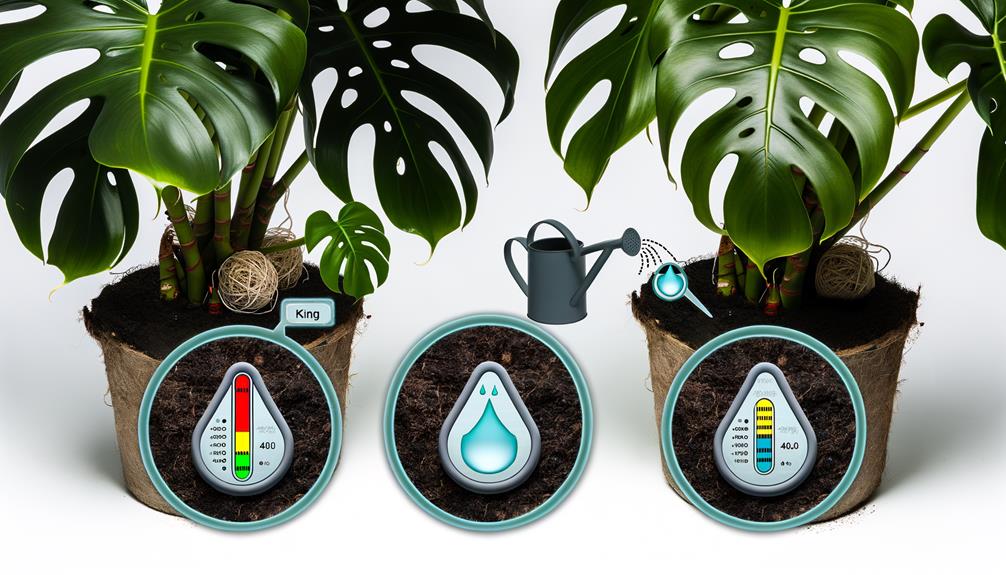
Ensuring prime hydration for Monstera King and Monstera Deliciosa necessitates a thorough understanding of their unique water requirements, rooted in their native tropical habitats.
Monstera King, with its robust foliage, demands consistent moisture levels, ideally through regular, moderate watering to maintain soil dampness without waterlogging.
Conversely, Monstera Deliciosa exhibits a preference for a more balanced hydration regimen, requiring the soil to dry out partially between waterings to prevent root rot.
Both species benefit from high humidity environments, mimicking their natural conditions, which can be achieved through misting or the use of humidifiers.
Monitoring soil moisture with a hygrometer can aid in precision, ensuring neither over- nor under-watering occurs, thereby promoting prime growth and health for these tropical plants.
Soil Preferences
The soil preferences for Monstera King and Monstera Deliciosa exhibit notable distinctions concerning ideal soil composition, drainage, and moisture levels.
Monstera King thrives in a well-aerated mix with high organic content, emphasizing the significance of drainage to prevent root rot.
Conversely, Monstera Deliciosa benefits from a slightly more moisture-retentive substrate while still requiring excellent drainage to support healthy root development.
Ideal Soil Composition
Both Monstera King and Monstera Deliciosa thrive best in a well-ventilated, nutrient-rich soil that promotes proper drainage and root oxygenation. To achieve this, a potting mix comprising peat moss, perlite, and pine bark is recommended.
Peat moss retains moisture without waterlogging, perlite enhances aeration, and pine bark provides essential nutrients and organic matter. An ideal pH range of 5.5 to 7.0 is essential for optimal nutrient uptake. Additionally, incorporating a slow-release fertilizer can guarantee a steady supply of essential macro and micronutrients.
It is crucial to avoid heavy, clay-based soils that impede root development. By adhering to these soil composition guidelines, both Monstera varieties can achieve robust growth and enhanced physiological health.
Drainage and Moisture Levels
Proper drainage and balanced moisture levels are crucial for the ideal growth and health of Monstera King and Monstera Deliciosa. These conditions prevent root rot and promote efficient nutrient uptake. Both species thrive in well-aerated soil mixtures that allow excess water to escape while retaining sufficient moisture for root absorption.
The intricate balance can be maintained through specific soil amendments and practices.
- Soil Composition: A mix containing peat, perlite, and pine bark is recommended.
- Watering Frequency: Watering should be adjusted based on ambient humidity and pot size.
- Pot Selection: Containers with drainage holes are essential to prevent waterlogging.
- Monitoring: Use a moisture meter to guarantee ideal soil dampness, avoiding both extreme dryness and saturation.
Understanding these parameters is essential for the best Monstera care.
Temperature and Humidity
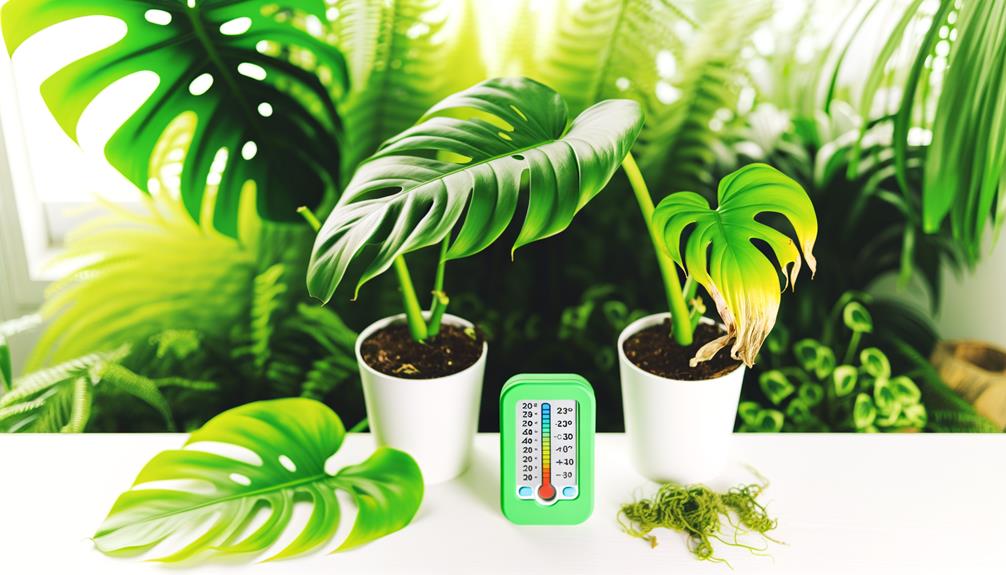
Monstera King and Monstera Deliciosa thrive best in environments where temperatures range between 65-85°F (18-29°C) and humidity levels are consistently high, ideally above 60%. These conditions mimic their native tropical habitats, facilitating ideal physiological processes such as transpiration and nutrient uptake.
Elevated humidity minimizes transpiration stress, maintaining turgor pressure and leaf turgidity. Conversely, temperatures below 60°F (15°C) or above 90°F (32°C) can impede growth and induce stress responses, including chlorosis and necrosis.
Both species exhibit enhanced growth rates and foliar development when maintained within specified parameters. Thus, maintaining controlled microclimates using humidifiers and temperature regulation systems is imperative for indoor cultivation, ensuring these Monstera species achieve their full ornamental potential.
Common Pests
Despite their strong nature, Monstera King and Monstera Deliciosa are prone to several common pests, including spider mites, mealybugs, and scale insects. These pests can have a significant impact on plant health by extracting sap, causing chlorosis, and promoting secondary fungal infections.
Mitigating their presence requires attentive monitoring and prompt intervention. Effective strategies include:
- Integrated pest management (IPM): Utilizing biological controls such as predatory insects.
- Chemical treatments: Applying horticultural oils or insecticidal soaps.
- Cultural practices: Ensuring proper air circulation and humidity control.
- Mechanical removal: Physically eliminating pests using water sprays or manual techniques.
Understanding and managing these pest threats is essential for maintaining the health of both Monstera King and Monstera Deliciosa in domestic and commercial settings.
Toxicity to Pets
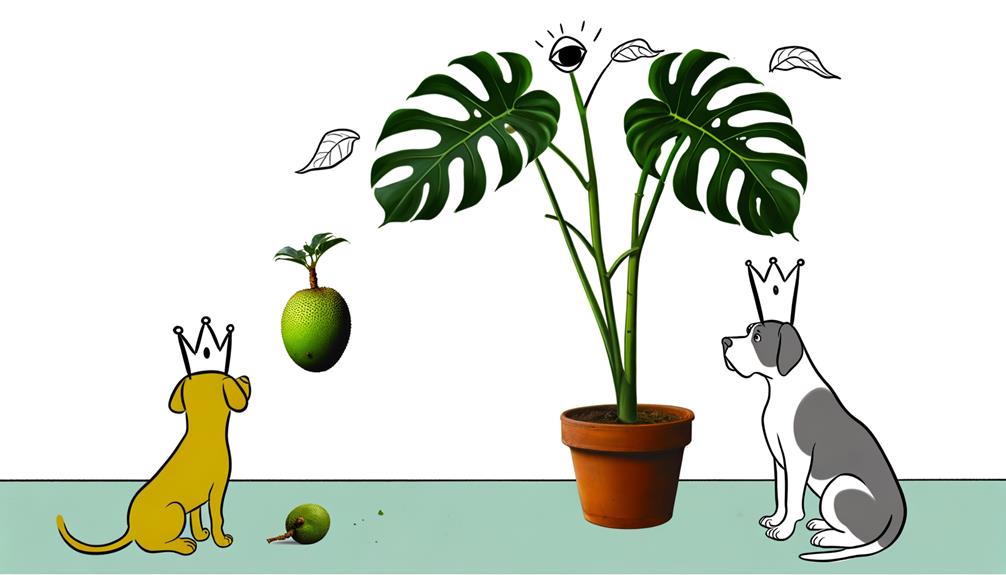
Given the robust care practices required to manage pests, it's equally important to address the toxicity of Monstera King and Monstera Deliciosa to pets, as both plants contain insoluble calcium oxalates that can cause significant health issues in animals.
When ingested, these needle-shaped crystals can penetrate the oral mucosa, leading to immediate pain, swelling, and irritation. Clinical signs include excessive drooling, vomiting, and difficulty swallowing. Severe cases may result in respiratory distress due to swelling of the throat and esophagus. Veterinary intervention is often required to manage symptoms and prevent complications.
It is advisable to keep these plants out of reach of pets or opt for non-toxic alternatives if pet safety is a primary concern.
Pruning and Maintenance
Proper trimming and maintenance of Monstera King and Monstera Deliciosa are crucial for promoting healthy growth and preventing disease. Both species benefit from regular inspection and strategic cutting to eliminate dead or damaged foliage. This practice enhances air circulation and light penetration, thereby reducing the likelihood of fungal infections. Additionally, trimming encourages new growth and helps maintain the plant's structural integrity.
Implementing these practices guarantees robust and resilient Monstera plants.
- Sanitize Tools: Always use sterilized cutting shears to prevent pathogen transmission.
- Remove Dead Leaves: Regularly eliminate dead or yellowing leaves to improve plant vigor.
- Trim Aerial Roots: Cut aerial roots selectively to control spread without damaging the plant.
- Shape the Plant: Trimming can be used to shape the plant and manage its size, especially in confined spaces.
Aesthetic Appeal
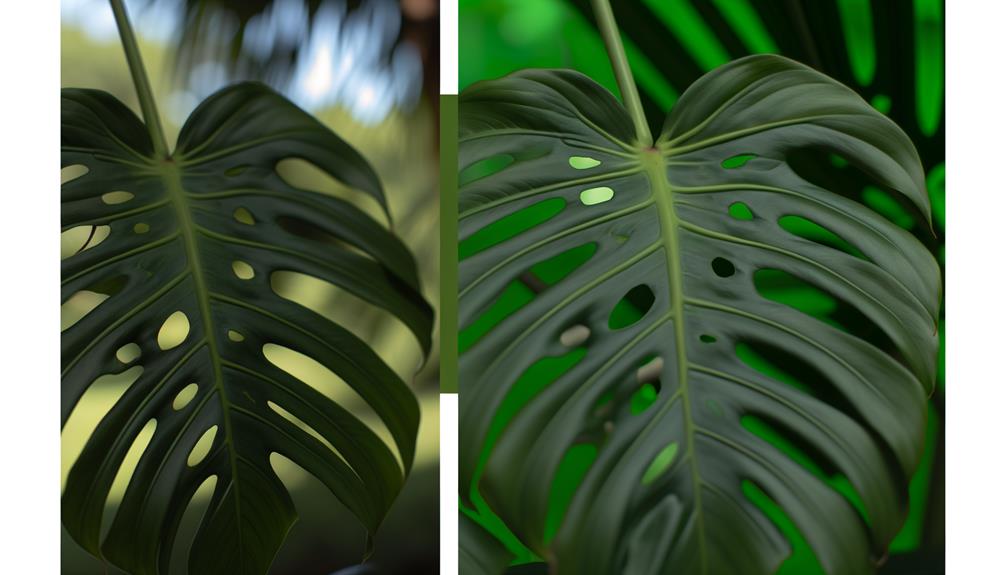
The aesthetic appeal of Monstera King and Monstera Deliciosa lies in their distinctive foliage, which features unique fenestrations and vibrant green hues that can enhance any interior space. Monstera King exhibits larger, more pronounced perforations, giving it a bold and dramatic presence. In contrast, Monstera Deliciosa's fenestrations are more delicate and numerous, contributing to a refined and intricate visual texture. Both species' leaves are characterized by their glossy sheen and rich, verdant coloration, which contribute to their striking appearance.
| Attribute | Monstera King | Monstera Deliciosa |
|---|---|---|
| Leaf Size | Larger, more pronounced | Medium, more delicate |
| Fenestration Pattern | Bold, dramatic | Refined, intricate |
| Coloration | Deep green, glossy | Rich green, glossy |
This comparison underscores their unique visual contributions to botanical aesthetics.
Conclusion
In sum, Monstera King and Monstera Deliciosa, each distinctive in origin, leaf morphology, and growth dynamics, cater to varied horticultural preferences.
The Monstera King, with its rapid growth and less stringent light requirements, contrasts the more iconic yet demanding Monstera Deliciosa.
Both species, though susceptible to similar pests and toxic to pets, offer unique aesthetic value.
As two sides of the same botanical coin, their cultivation reflects a tapestry of plant care complexities and ecological intricacies.

